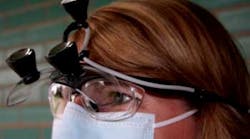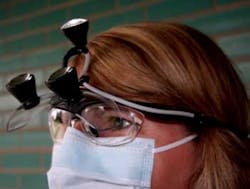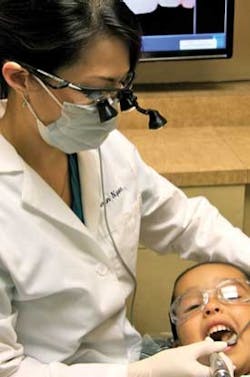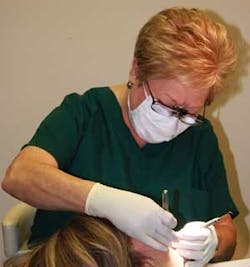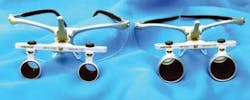Prevent needless aches and pains while improving clinical efficacy
by Anne Nugent Guignon, RDH, MPH
Decades ago, workplace safety was rarely mentioned in either the academic world or the treatment room. As the number of dental health-care workers who were getting hurt or were forced into premature retirement increased, the concern for workplace safety grew.1-8 Clinicians started considering ergonomic solutions to either prevent injuries or help resolve the daily aches and pains.
A small but growing number of dental hygienists, many of whom were getting injured, have started purchasing their own equipment to protect their bodies and their careers.
The power of a neutral body posture
Maintaining a neutral body posture is the key principle to creating workplace safety.9-11 Being able to see the oral cavity clearly and maintain a healthy working posture is nearly impossible without some type of magnification.12-13 Properly fitted, high quality magnification loupes are clearly a critical component for preventing unnecessary injuries.12-14 Every year, magnification becomes more of a mainstream tool in the treatment room. Whether you’re using micro-ultrasonics or hand instrumentation, many now consider magnification the standard of care in clinical dental hygiene.
Those who use properly fitted magnification understand the benefits and would not consider practicing without loupes. While our instincts have demonstrated the benefits, research has now shown that magnification loupes do indeed improve posture as well as enhance visual acuity.14-16 An increasing number of dental hygiene programs highly recommend magnification loupes, and many schools now mandate magnification for students.17
Here is an analogy for the doubting Thomas crowd — those who think magnification loupes are a luxury, too expensive, or not necessary for providing clinical care. You would never consider driving a car that did not have a braking system, or even one with worn-out brakes. You also would not want to use a car fashioned with a periscope instead of a full, clear windshield. While these analogies are far-fetched, every clinician who attempts to practice without a healthy posture and good visual acuity is at an increased risk for developing a career-altering or career-ending event. 1,4,7,14-16
Reasons for not using magnification include cost, weight, patient acceptance issues, multiple practice locations, and the perception that loupes are only for correcting vision issues that often occur during middle age. Thousands of clinicians begin wearing loupes every year, and most are quickly convinced that the benefits of magnification far outweigh the expense or time it takes to learn to use this technology.12,13
Magnification loupes, also known as surgical telescopes, are multifunction devices. Loupes provide an enhanced view of structures in and around the mouth in addition to providing eye protection and reducing neck, back, shoulder, and forearm stress.
In an effort to economize, some people purchase reading glasses or clip-on reading magnifiers that exceed their personal vision needs rather than opt for true magnification loupes. On the surface, this may seem sensible, especially considering the economic downturn. In reality, this decision has the potential to accelerate a workplace injury. Reading glasses are designed to enhance the view of a flat plane, like a page in a book, not a deep operating field like the oral cavity. Wearing reading glasses that are too strong will magnify an image, but destroy healthy postures. In order to stay in focus, one has to lean forward, creating unnecessary stress on the neck, shoulders, and back.
In addition, most reading glasses do not provide adequate eye protection. Others try to wear someone else’s hand-me-down loupes. This is rarely a good idea, especially with custom-made magnification, since the personal physical measurements of the new user would need to match those of the previous user.
Advances in magnification optics and frames
Years ago, the selection of magnification devices was limited to clip-on reading magnifiers, flip-down jeweler’s loupes attached to a rigid headband, surgical telescopes embedded directly into large black plastic frames, or bulky aviator-style metal models. There were also hinge-mounted flip-up oculars attached to heavyweight metal frames.
Loupes are now available in an ever-increasing variety of lightweight, stylish frames as well as headbands or high-quality safety glasses. Dental hygienists are clinicians just like dentists — therefore, there is no such thing as a hygiene loupe. Magnification loupes range from entry-level models to loupes with highly sophisticated optical systems. So the choice is yours. More hygienists are now purchasing high level magnification systems previously only worn by doctors.
According to industry experts, over 92% of all clinicians select through-the-lens (TTL) magnification systems. The oculars mount directly into the carrier lens in a pair of glasses. TTLs are custom-made to match each clinician’s visual needs and measurements.
A few clinicians select flip-up or headband-mounted loupes. The oculars attach via a small hinge, making it easy to move the loupes out of the way when talking to a patient or making chart notes.
A hybrid design featuring a TTL magnification system built into a flip-up carrier lens gives users the best of both technologies.18
With the increasing use of laser technology, loupes are now available where both the telescope and the carrier lenses have a built in protective filter compatible with soft tissue laser wavelengths used in dentistry today.18
Personal vision prescriptions can be incorporated into a magnification system in a variety of ways. It is wise to have a current eye prescription before placing an order. Flip-up systems incorporate personal vision prescriptions into the traditional glasses frame. A local optical shop can make changes at any time.
TTL systems are custom fabrications. Personal prescriptions are available from some companies; others do not offer this service. Prescription needs are built into the ocular at the factory. Some companies do not have an additional fee for this service. Ask if changes can be made at a later date as visual needs change. This type of flexibility can extend the life of your loupes through years of practice. The hybrid TTL/FU model is designed to accommodate a custom vision insert, which can be ordered at any time, eliminating the need to send the loupes back to the factory for an update.
Magnification nuts and bolts
Optical resolution is one of the most critical factors when considering loupes. The image viewed through the oculars should be crisp and uniformly clear from edge to edge. High quality loupes are made with glass optics, resulting in outstanding images.13 The better the quality of the glass, the higher the resolution, which is the ability to see small structures — such as the markings on a periodontal probe — clearly and distinctly. High quality optics result in an improved image and lessens the potential for eye fatigue. Plastic optics, which are often found in less expensive loupes, do not offer the highest level of visual acuity.
Lack of magnification creates dangerous, stressful postures, including forward neck position, hunched shoulders and abducted arms. Photo courtesy of Mitzi White, RDH.
The strength or power of magnification is another factor in visual acuity. 13 Diopter numbers, often used to describe strength, can be misleading. Diopter measurements relate to vision corrections found in eyeglasses, not to magnification systems designed to enlarge an image.
There is no industry-wide standard regarding power. One manufacturer’s 2.5x can be different than a competitor’s loupes advertised to be the same strength. A side-by-side comparison is the only way to distinguish differences between various brands of loupes.
Most clinicians initially select medium strength loupes. But over time many make the transition to higher power magnification. Moderate strength magnification provides a view of the entire oral cavity. As strength increases, a smaller area is viewed in greater detail.
Width of field and depth of field are other important considerations when selecting magnification loupes.12,13 Width of field determines how many teeth can be viewed when using magnification. Clinicians can see the entire oral cavity using either medium strength or some high power loupes. As the strength of the magnification increases, the width of field decreases so fewer teeth are seen.
Depth of field refers to the ability to see objects in a three dimensional range instead of a flat plane. Medium strength magnification typically results in a five- to six-inch depth of field, allowing a clear view of the entire oral cavity without repositioning one’s head. TTL oculars sit closer to the eye, resulting in a wider field view, greater depth of field, and a larger volume of light passing through the ocular — a feature particularly beneficial as the eyes age.
Magnification loupes should be designed to fit the user. Precise measurements allow loupes to be custom made for a specific clinician’s needs.12,13 Facial geometry is a critical determinant in selecting the most appropriate magnification system and frame style:
- A prominent nose profile for those of Western European background differs dramatically from those who have Asian facial geometry.
- Pupillary distance (PD) determines distance between the oculars. Those with close-set eyes have a narrower PD than those with wide-set eyes.
- A correct declination angle (DA) allows one to see the oral cavity while maintaining a neutral body posture.
- Convergence point (CP) is the point where one sees a single image through the loupe’s binocular system.
- Working distance (WD) is determined by measuring the distance from the front of a clinician’s eye to the facial of the first molar.
An ideal working distance allows the clinician to position the patient’s head at waist level, keeping the forearms close to the trunk of the body and parallel to the floor. As the eye loses flexibility over time, working distance measurements are lengthened to accommodate these changes, a phenomenon frequently experienced when clinicians begin to use reading glasses, also known as cheaters.
Theoretically, several clinicians could share pair of flip-up loupes if they have the same working distance, facial geometry, and do not require any personal vision correction. If sharing does occur, each clinician will need to readjust the oculars to fit their personal pupillary distance, convergence point, and declination angle.
Loupes offer an opportunity to improve one’s posture.12-15 Clinicians who slump or lean their heads forward while being measured will not receive the positive postural benefits derived from properly fitted magnification. To take advantage of this ergonomic health benefit of magnification, the clinician should get measured while sitting with an erect head and shoulders in a neutral posture, similar to the posture one assumes when reading, writing, or eating. However, changing posture can be challenging, as muscle memory will often drive hygienists back into their original comfort zones. If improving posture is not a primary concern, the clinician should get measured in the position he or she is most comfortable working in.
Putting magnification in the comfort zone
Many types of frames support magnification oculars. Newer, lightweight metals, such as titanium are sturdy without being heavy. Sport frames are made with plastic as well as highly durable carbon composite materials. The temples on carbon composite frames and some titanium frames can be adjusted to fit a user’s head. The precise temple and nose pad support systems on these adjustable frames may eliminate the need for a head strap.
Clinicians often add an auxiliary headlight system at a later date. To avoid disappointment, inquire if the magnification frame is built to support a headlight.
Larger carrier lenses are necessary for clinicians needing a steep declination angle or higher strength oculars, which weigh more. While loupes weigh more than standard glasses, magnification systems designed to distribute weight evenly are much more comfortable to wear than those where the majority of the weight is supported on the nose. Most clinicians use head straps to counterbalance the weight of the loupes and prevent slipping, which maintains the loupes at a precise visual point.
Ultra small oculars as compared to standard size.
Nose pads and frame temples should be adjusted to provide proper support and comfort. To maintain optimal comfort, periodically replace the silicone nose pads or worn-out head straps.
Transitioning into magnification
Learning to wear loupes is much like learning to ride a bike. Most need an adjustment period to fully incorporate loupes into the clinical day. Making up one’s mind that wearing loupes is important is key in the transition. Don’t get frustrated if it takes a week or two to become fully acclimated. It may take even longer for those who practice only a few days a week.
Don’t give up. If something does not seem right, contact the company’s customer service department or the sales representative for pointers. Make sure the nose pads are comfortable. Use a head strap to balance the weight. Initially, wear the loupes for short periods of time, starting with routine procedures such as polishing or an intraoral exam. Avoid excessive head motion. Relax and let the magnification technology work. As you become more familiar with magnification, lengthen the wearing time.
Those who are prone to motion sickness should approach the adjustment period more slowly, but with confidence. Some find relief from pressure point wristbands designed to counteract motion sensations. Some clinicians choose loupes that are made with very small diameter optics, which lessens the overall weight of the system but narrows the width of field, creating a sensation of tunnel vision — a phenomena that can increase motion sickness.
A face mask, correctly worn, can dramatically improve the comfort of magnification. Consider an anti-fog mask that provides a great seal, adapts closely to individual nose geometry, and is built with a comfort strip to help support the weight of the loupes. Face shields that clip on to the temples provide adequate clearance for magnification loupes.
Some worry about the patients’ reaction to magnification, but this is a moot point in most offices today. The majority of doctors now wear loupes. It is only natural for dental hygienists and dental assistants to use magnification. Any resistance disappears when patients learn that magnification provides better visual acuity, translating into improved dental care. Introducing loupes to children is not an issue either. After all, patient care is just that, patient care. And healthy dental health-care workers are more relaxed and attentive to the task at hand.
Taking care of your investment
Learn how to care for magnification. Follow the manufacturer’s written recommendations, and don’t expect a company to provide a complimentary repair or replacement for loupes damaged by carelessness or improper cleaning techniques.
Take care not to scratch the oculars while cleaning. For waterproof oculars, carefully remove visible debris by rinsing with warm, soapy water. Rinse with clear water and dry with a clean, soft microfiber or optical cloth. Avoid using paper towels or rough fabric on the oculars. Micro-fine scratches compromise visual acuity.
Loupes can be disinfected with most surface disinfectants. Special precautions must be taken if the oculars are rated as water-resistant, not waterproof. Companies that sell water-resistant oculars will not replace the magnification if moisture gets into the ocular.
At the end of the day, store your magnification in the padded box or pouch provided by the manufacturer. Avoid storage that has rough interior surfaces. Many clinicians work in more than one practice and transport their loupes from location to location. Keeping your car keys next to the storage box will ensure that your loupes make it to the next practice location.
Company policies vary with respect to trial periods, warranties, replacements, and other customer service activities. Most money-back guarantee trial periods are at least 30 days, and many extend to 45 days or even longer in certain circumstances.
Take time to read the fine print and ask questions. For example, who pays either the initial or return shipping? Is the trial period based on business days or calendar days, and is there a restocking fee? What exactly is covered in the warranty, and how long does it last? Does the warranty only cover specific parts or the entire pair of loupes, including oculars and the frame? Does the company have any type of extended warranty plan? What is considered normal wear and tear?
Investing in a pair of loupes is a serious and wise decision. It makes sense to research what is available via the Internet, but it is important to assess product quality with a hands-on experience. This is one purchase where custom measurements taken by a company representative at either a professional meeting or in one’s clinical setting make the most sense.
High quality products cost more but are typically made with high-grade components. Many of the better systems are made here in the United States.
Like any precision piece of equipment, loupes should be inspected periodically for wear. Worn-out screws and nose pads should be replaced. Check to see if a company has an annual plan that covers cleaning, refurbishing, and prescription changes.
Making magnification a reality
The final question typically comes down to dollars and cents. In other words, who is going to pay for the magnification? More hygienists are purchasing their own loupes, a step taken as a matter of securing a safe future.
Any purchase or business related-expense not reimbursed by your employer can be claimed as a tax deduction when you file your income tax return. Check the details with your tax specialist. Companies often offer special payment plans, allowing payment over time, and one company has special rates for ADHA members.
Some hygienists negotiate special arrangements with their doctors. Magnification can be used as a bonus or in lieu of a dollar raise. Some ask doctors to purchase the loupes and then deduct a specified amount of pretax dollars every pay period. In the case of these alternative arrangements, ask your tax expert who will be allowed to take the tax deduction.
Some doctors supply loupes to valued employees, but having to purchase your own loupes is not a sign that your services are not highly regarded. A word of caution to those whose doctors pays for all or part of the loupes: Make sure all ownership agreements are in writing to avoid an unexpected dispute in the future.
Rather than focus on a litany of reasons why magnification isn’t part of your clinical armamentarium, consider loupes a proactive way to protect your health and well-being. If money is an issue, add up the dollars spent on treatments trying to fix your aching back, shoulders, and neck. Loupes are a solid way to help prevent aches and pains, enhance your clinical expertise, lessen the chance of injury, and prolong your clinical career and ability to earn a living.
The bottom line is that properly fitted magnification loupes move your career into a preventive mode away from a crisis just waiting to happen. Clinicians who wear loupes consider magnification a great return on investment. You and your career are worth protecting.
Anne Nugent Guignon, RDH, MPH, provides popular programs, including on biofilms, power driven scaling, ergonomics, hypersensitivity, and remineralization. Recipient of the 2004 Mentor of the Year Award and the 2009 ADHA Irene Newman Award, Anne has practiced clinical dental hygiene in Houston since 1971.
References
- Marklin RW, Cherney K. Working postures of dentists and dental hygienists. J Calif Dent Assoc. 2005 Feb;33(2):133-6.
- Morse T, Bruneau H, et al. Musculoskeletal disorders of the neck and shoulder in dental hygienists and dental hygiene students. J Dent Hyg. 2007 Winter;81(1):10.
- Ohlsson K, Attewell RG, et al. Repetitive industrial work and neck and upper limb disorders in females. Am J Ind Med. 1995 May;27(5):731-47.
- Yamalik N. Musculoskeletal disorders (MSDs) and dental practice Part 2. Risk factors for dentistry, magnitude of the problem, prevention, and dental ergonomics. Int Dent J. 2007 Feb;57(1):45-54. Review.
- Finsen L, Christensen H, Bakke M. Musculoskeletal disorders among dentists and variation in dental work. Appl Ergon. 1998 Apr;29(2):119-25.
- Hayes M, Cockrell D, Smith DR. A systematic review of musculoskeletal disorders among dental professionals. Int J Dent Hyg. 2009 Aug;7(3):159-65.
- Hamberg-van Reenen HH, van der Beek AJ, et al. Does musculoskeletal discomfort at work predict future musculoskeletal pain? Ergonomics. 2008 May;51(5):637-48.
- Lindfors P, von Thiele U, Lundberg U. Work characteristics and upper extremity disorders in female dental health workers. J Occup Health. 2006 May;48(3):192-7.
- Pheasant S, Haslegrave CM. Bodyspace: anthropometry, ergonomics, and the design of work. Bocca Raton: Taylor and Francis. 2006.
- Helander M. A guide to human factors and ergonomics – 2nd ed. Boca Raton: Taylor & Francis, 2006.
- Novak CB. Upper extremity work-related musculoskeletal disorders: a treatment perspective. J Orthop Sports Phys Ther. 2004 Oct;34(10):628.
- Syme SE, Fried JL, Strassler HE. Enhanced visualization using magnification systems. J Dent Hyg. 1997 Fall;71(5):202-6.
- Pencek L. Benefits of magnification in dental hygiene practice. J Prac Hyg 1997;6(1):13-1.
- Sunell S, Rucker L. Surgical magnification in dental hygiene practice. Int J Dent Hyg. 2004 Feb;2(1):26-35.
- Branson BG, Bray KK, et al. Effect of magnification lenses on student operator posture. J Dent Educ. 2004 Mar;68(3):384-9.
- Maillet JP, Millar AM, et al. Effect of magnification loupes on dental hygiene student posture. J Dent Educ. 2008 Jan;72(1):33-44.
- Thomas J, Thomas FD. Dental hygienists’ opinions about loupes in education. J Dent Hyg. 2007 Fall;81(4):82. Epub 2007 Oct 1.
- Laser loupes. http://orascoptic.com/index/orascoptic-products-loupes-laser-2Orascoptic web site. Accessed May 3, 2010.
